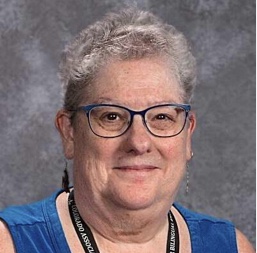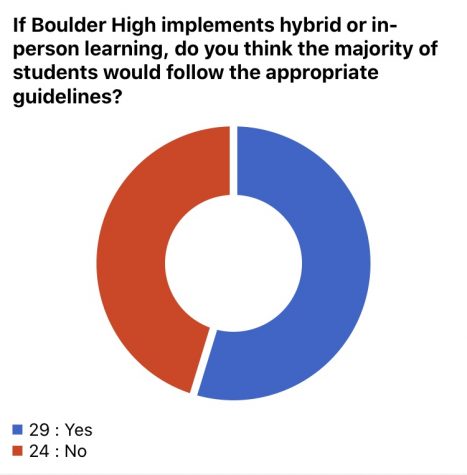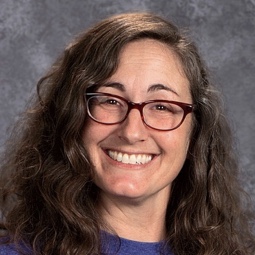Ready to Return?
Boulder High’s teachers weigh in on a possible return to in-person learning
With the COVID-19 pandemic still a major issue in the U.S. and across the world, how and when schools should return to in-person learning remains a point of controversy. Although Boulder High is still in stage one (completely remote learning) of its five-stage reintroduction plan, BVSD’s Working Advisory Group presented their suggestions to the Board of Education on Sept. 22 and expressed that it is “highly probable” that high schoolers will return to in-person learning one day a week starting Nov. 3. With a return to in-person learning possibly in the near future, we reached out to teachers to get their perspective on a return to school.

In a survey responded to by 53 Boulder High teachers, we asked them a variety of questions regarding a return to in-person learning. When asked if they would feel comfortable participating in in-person teaching if Boulder High decided to implement a hybrid form of learning, 60 percent said yes.
Ms. Cornacchione, one of the BHS faculty members who agreed to be interviewed for this article, shares this perspective and said that although she worries about the virus for herself, her family and the community, she would like to see us back in school. “I think I am ready to teach in my classroom, with appropriate safety measures, and I’m ready for my kids to be back in their classrooms,” she said. “I don’t feel this is how we’re meant to live and to learn.”
Other teachers are not so quick to jump back into the classroom under the current circumstances.

Ms. Campos, who mentioned that she has lung problems herself and regularly visits her 94-year-old mother, remarked that she does not feel comfortable returning to school for the time being. “I would love to get back, but I don’t think I am going to be able to go back until there is a widespread vaccine,” she said.
Although Ms. Campos is uncomfortable with returning to school herself, she believes that students and teachers who are not at high risk of contracting COVID should return to school when it is possible for them to do so. “I do think we should get kids back to school when we can, I just think there are some kids and some adults that probably aren’t going to be able to go back with everyone else.”
While the majority of teachers surveyed said they would feel comfortable with some form of hybrid learning, this positive sentiment was not shared when it came to full in-person learning. In fact, when BHS faculty members were asked about the prospect of returning to school entirely in person, only 41 percent said they would feel comfortable doing so.
Despite the differing perspectives of many teachers regarding a returning to school, the vast majority are confident in the Boulder High administration’s commitment to safety. When asked if they think the school’s administration would take the proper precautions to keep students and teachers safe if in-person or hybrid learning was implemented, 81 percent of teachers surveyed responded yes. Ms. Campos noted that “there are very few people in the building and they are still cleaning everything.”

There is a distinction, however, between teachers’ perception of the administration’s ability to keep students and faculty safe, and teachers’ perception of students’ commitment to following safety guidelines. Just 55 percent of teachers surveyed think that the majority of students will follow the appropriate guidelines if in-person or hybrid learning was implemented. Mr. Castleman, who had COVID-19 in the spring of 2020 and has since recovered after suffering from the illness for a month, expressed that a lack of adherence to guidelines would be his biggest concern. He explained, “I don’t like wearing the mask any more than anyone else does, but especially once you have 15 or 20 people in an enclosed space, it becomes really important that everyone follows the procedure. All it takes is one person not doing it and the whole thing can fall down.”
A crucial component of a safe return to school is ensuring that students and teachers respect social distancing; given Boulder High’s limited indoor classroom space, this issue has been especially concerning to some teachers.

Ms. Rossin shared her concerns about indoor classroom space saying, “As far as my experience in the oldest high school in Colorado, I feel quite nervous [about the possible lack of classroom space,] to be honest.” Despite her uneasiness about adequate indoor space, Ms. Rossin is optimistic about Boulder High’s ability to mitigate this issue by implementing outdoor classrooms. In addition to teaching at Boulder High, Ms. Rossin works in festival production during the summertime and has many of her own ideas on how to make outdoor learning a feasible alternative. “I think with 300 days of sunshine a year in Colorado, and having all of the field space that we have, that would be a really cool innovation and a way to get us back to school.” She adds, “Being outside is a much safer option than being inside, so I would love to see it happen.”
It is evident that teachers and students alike are eager to return to school and get back to some sort of in-person learning. Yet, despite a strong desire for a return to normalcy and a planned shift to stage 3 on Nov. 3, the future of the learning experience at Boulder High for the rest of the academic year remains uncertain.

Conner Reagan is a senior at Boulder High School and a new staff member of The Owl. He is interested in a number of journalistic topics ranging from local and national sports to contemporary social and political issues. This year, Conner is eager to learn more about his peers and the Boulder High community while also working to improve his writing. Outside of school, Conner is a member of the Boulder High basketball team and one of four returning varsity players. When he is not on the court, you can find him hitting the slopes on a powder day or enjoying quality time with his friends. Conner has a golden retriever named Nala and is the youngest of four kids, all of whom attended Boulder High...

